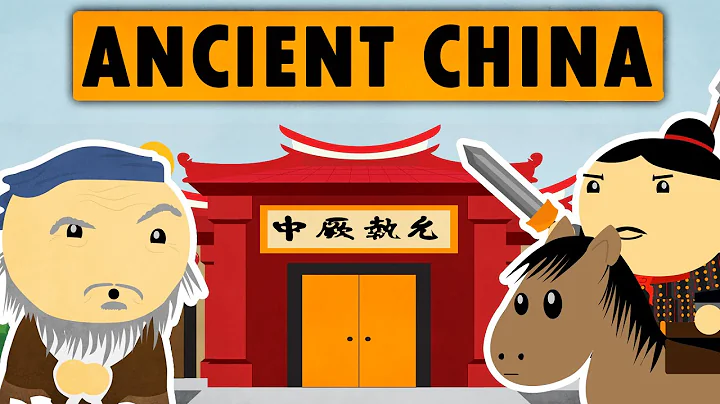Civilization Disappeared in Chinese History——Ancient Shu Kingdom (1) The Origin of Ancient Shu Kingdom
I read a novel before, titled "The Last Taoist Priest in China", which contains ancient Shu Kingdom As well as the records of Can Cong and Yu Fu. In this novel, the primitive religious culture of the ancient Shu Kingdom is regarded as the starting point of Chinese Taoist culture. At that time, I looked at it with the mentality of reading novels and did not have a deep understanding. I am reading it today. In the books of the Shang and Zhou Dynasties, I once again saw records about the ancient Shu Kingdom. There are also records of "Shu Shou Nian" and "Zheng Shu" in the oracle bone inscriptions unearthed in the Yin Ruins. When I was curious, I checked the relevant information. I originally planned to write an article. After thinking about it, I needed to write out the origin of ancient Shu, the civilization of ancient Shu, and the connection between ancient Shu’s primitive religious culture and modern Taoism. The content is too much and it seems messy, so I am going to divide it. Three articles, this article mainly writes the origin of ancient Shu.

Regarding the existence of the ancient Shu Kingdom, the earliest record is in the oracle bone inscriptions unearthed in the Yin Ruins. Later, I checked it. The detailed records of the ancient Shu Kingdom are in the "Huayang Kingdom" It can be found in "The History of Shu", and there are related records in "The Book of the King of Shu". According to the records of "The History of Huayang Kingdom·Shu": Since the kings have high merits, Baoxie is the front door, Xiong'er and Lingguan are the back households, Yulei and Emei are the city walls, and Jiang, Qian, Mian, and Luo are Chize. Take Wenshan as animal husbandry, and Nanzhong as the garden. Based on the current regional division, the territory of the ancient Shu Kingdom includes the Chengdu Plain, the central Sichuan hills, and the Hanzhong Basin. With the excavation of the Sanxingdui and Jinsha sites, the ancient Shu Kingdom gradually emerged from its dusty history, proving that in the primitive society and slave society, China still had a highly developed country.

Then let’s talk about the origin of ancient Shu. The opening chapter of "The History of Huayang · History of Shu": Shu is the country, originated from the emperor, and is tied to Ba. To the Yellow Emperor, his son Changyi married the daughter of the Shushan clan, and gave birth to Gaoyang, which was for the emperor. Sealed his subordinates in Shu, and he was named Houb. This paragraph clearly pointed out that Gaoyang's concubine was sealed in the territories. The Gaoyang clan's concubine here should be the first king of the Shu Kingdom, Cancong, and a descendant of the Yellow Emperor. "Huayang Guozhi" says: "There is the silkworm cluster of the Shu lords, whose eyes are vertical, and they were first called kings. The second king is called Baiguan. The second king is called Yufu." And "The Book of the King of Shu" also records: "The first name of the king of Shu was silkworm. Cong, the descendant of Baiguan, the latter is named Yufu. These three generations are hundreds of years old, and they are all deified and immortal, and their people are also quite like Wang. "It can be confirmed in the cultural relics unearthed at Sanxingdui that the "Zongmu" is the silkworm Cong. Image characteristics. The eyeballs of the Sanxingdui bronze portrait with longitudinal eyes protrude more than ten centimeters forward from the eye sockets, and some faces have a dragon cast on the bridge of their noses. This should be the origin of the ancient kingdom of Shu.

Regarding Cancong, there is also a record that Cancong is a Qiang, and it is necessary to say it separately here. First of all, we must know that there is a difference between the Qiang people here and the later Western Qiang, Eastern Qiang and the current Qiang people. The Qiang people here refer to the ancient Qiang people. The ancient Qiang people are from the ancient times and live in the present-day China. An important group in the area west of the mountains. Ancient Qiang is not a nation, but a collective name for many different ethnic groups in the west. They have different cultures, traditions, customs, costumes, languages, etc. The only similarity is that they live in the grass. They mainly rely on migrating agriculture and animal husbandry, so the ancient Qiang people and the Qiang people are not the same concept.

When it comes to the relationship between the Qiang people and the Cancong, we must start with the ancestors of the ancient Qiang people. The ancestor of the ancient Qiang people was Emperor Yan, "Qiang is the San Miao, the descendant of Jiang surname", "The Book of the Later Han Dynasty · Xi Qiang Biography" contains: "The origin of Xi Qiang, originated from San Miao, Jiang surname is different. Its country is near Nanyue. The four evils of the Shun flow and the three dangers of migration, the Qiang area in the southwest of Heguan is also the same. According to modern historians, the Shushan tribe is a branch of the Jiang tribe of the Yandi family, the ancestor of the humanities of the Chinese nation. It is a group of people from northwest China. The "Ginger" people on the plateau. The Jiang people are called "Jiang people" in matrilineal society. After entering the patrilineal society, they are called "Qiang people." In the historical process of human reproduction and development, ancient Qiang tribes moved south along the river valley into Shu The land, in the Minshan and Ruoshui basins, lives on the mountainous terrain, and the stone is a cave, known as the Shushan clan. During the Xia Dynasty, the descendants of the Shushan clan became king in Shu and established the State of Shu. The Mingshan County Annals of the Republic of China contained: "Can Cong's Tsing Yi teaches people to farm silkworms,Sun’s residence is called Qingyi Qiang.” It means that in the Xia Dynasty, the Shushan clan started farming culture under the leadership of Can Cong. Because their ancestors came from the ancient Qiang people, the area they lived in was also called “Qingyi Qiang”. ".









![[Documentary] China's Beginning - Xia Dynasty (2070 - 1600 BC) 夏朝 - DayDayNews](https://i.ytimg.com/vi/qXrkF5Nd4i8/hqdefault.jpg?sqp=-oaymwEcCOADEI4CSFXyq4qpAw4IARUAAIhCGAFwAcABBg==&rs=AOn4CLAzmoNIujveGHX8A8r4GMFJF8OcLA)












